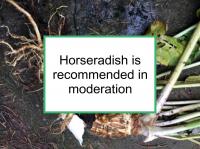Like broccoli and kale, horseradish (Armoracia rusticana) is a cruciferous vegetable. Components of horseradish have been shown to have anti-hypercholesterolemic, antimutagenic, and both antioxidant and pro-oxidant effects. Horseradish and wasabi (Japanese horseradish) have been reported to have anti-cancer effects.
For example, horseradish and wasabi have been shown to inhibit the proliferation of colon, lung, pancreatic, prostate and stomach cancer cells. These chemopreventive qualities appear to be due to horseradish isothiocyanates, primarily allyl isothiocyanate (AITC) and phenethyl isothiocyanate (PEITC).
Breast cancer-related effects of eating horseradish
Isothiocyanates found in cruciferous vegetables have been shown to have chemopreventive and anti-angiogenic effects in breast cancer cell studies and animal models of breast cancer. While one carefully designed study of Chinese women found that cruciferous vegetable consumption was associated with significantly reduced breast cancer risk, population studies specifically evaluating the impact of consuming horseradish or wasabi are not available.
AITC
Oral administration of AITC has been demonstrated to restore levels of proliferation and aromatase activity to near normal levels in a rat model of breast cancer. Another rat study found that AITC prevented mammary tumor angiogenesis and invasion. A cell study observed that AITC induced ER+/PR+ breast cancer cell death in a dose-dependent manner by causing DNA damage and altering DNA damage repair proteins. A 2025 study reported that AITC reduced the growth and viability of triple positive (ER+/PR+/HER2+) HER2-positive breast cancer cells.
AITC has also been shown to reduce doxorubicin-induced heart damage (cardiomyopathy) in a rat model of chemotherapy.
PEITC
PEITC has been shown to reduce the growth of human breast cancer cells and decrease angiogenesis (the process by which tumors send out signals to induce surrounding normal tissues to grow new blood vessels into the tumor). In addition, PEITC has been demonstrated to inhibit the growth of HER2+ mammary tumors in mice and inhibit metastasis to the brain in a mouse model of breast cancer.
PEITC has also been found to enhance the sensitivity of the breast cancer cells to radiotherapy and doxorubicin.
Additional comments
Uncooked horseradish root typically is used in making horseradish sauce (the root can also be used simply grated). This preserves much of its anti-cancer properties, since cooking can substantially reduce or destroy isothiocyanates.
Horseradish and wasabi are both toxic at high doses.
Sources of information provided in this webpage
The information above, which is updated continually as new research becomes available, has been developed based solely on the results of academic studies. Clicking on any of the underlined terms will take you to its tag or webpage, which contain more extensive information.
Below are links to 20 recent studies concerning this food and its components. For a more complete list of studies, please click on horseradish.
